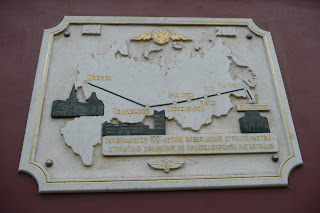 |
| Lenin's statue is still evident |
We got to breakfast before 9 am, so that there was something left to us. This wasn’t necessarily a good move – the food was lukewarm and unappetising, but, at least, we avoided the creamed rice (which was an off-white colour today, in contrast to the yellow colour of yesterday).
The day itself is beautiful. The sky is a cloudless blue and the wide Angara river viewed from our room has barely a ripple, even though it moves quite quickly.We checked-out of the hotel mid-morning, leaving our bags in their care, and headed off to explore. We headed to the north-east of the central city. On the way, we found the cental market, which was a crowded, bustling place, selling plants, vegetables, meat and all manner of other products. It was clearly a popular place with locals.
 |
| Volonsky House |
We took a tram back into town and found a beer garden for lunch.
After that, it was off to the Supermarket to stock up for the train. I found a deightful cask of what I hope is French red (one "French" that I found proved on examination to be from that impressive appelation "melange of Europen countries").
 |
| A quiet lager by the Angara River |
It was a beautiful clear and warm day - the best that Irkutsk can provide. It seemed as though every young lady had put on their most fashionable outfits and their highest heels because we were in town.
We repaired to a floating kiosk on the river and had a few beers, before going back to the hotel to meet our transport and head for the Baikal train at the station. The train was to be our home for the next two days.Katya arrived, took us to the train station and saw us safely onto the train. This is train #009, called the Baikal. First class is comfortable, but not as well laid out as the Rossiya (no shelves, less handing space). There seem to be only two cabins occupied in our wagon.
Dinner was a hot roll stuffed with sausage at the train station, followed by cheese and bread on-board. We accompanied this with a charming little red that we found at the supermarket - a 3 litre cardboard box of French Rouge Moelleux with the wonderful name of Garson. (a beautiful, unnecessary over-correction of the Russian “C” to the European “S”). Of course, the supermarket stocked every form of wine except Russian.




















